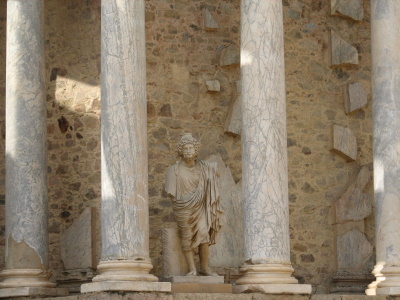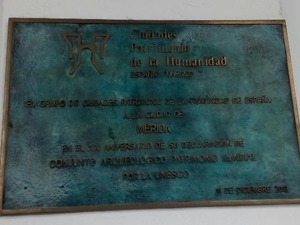Mérida

The Archaeological Ensemble of Mérida holds the remains of many public buildings that were the trademarks of a major Roman provincial capital.
The city was built as Emerita Augusta in 25 BCE, adhering to a strict Roman urban plan. Mérida preserves both public and private buildings from Antiquity, such as the theatre, amphitheatre and engineering works. The Ensemble also includes a few later monuments like the Moorish Alcazabar and two early Christian churches.
Community Perspective: The quality lies in the ensemble of the various components, as together they show every aspect of life in a Roman city. There’s a combined ticket that gives you access to all. The National Museum of Roman Art is also worth visiting.
Map of Mérida
Community Reviews
KngAlaric
Merida has some cool Roman remnants, but they are all trapped behind fences, which I guess is understandable. But, if you arrive on a day in which they are closed, the fences are also ivied, so you can't see much.
Also, the old town is getting a facelift, which doesn't really make it seem like an old town at all. Perhaps they are readying for hordes of modern shoppers. Maybe I missed the allure, as this was simply a stopover town on our travels.
Had I been there on a day when things were open, I might have felt like I was walking around Rome. But, I also might not have.
Hubert

Under the Roman name Emerita Augusta, Mérida was an important centre on the Via de la Plata (Silver Road), the connection between Seville in Andalusia and Astorga in the north. The ancient city had about 50,000 inhabitants, quite large for the time. Today, Mérida is only slightly larger than it was in Roman times, a cosy and leisurely town compared to other sites in Spain.
I visited Mérida in May 2019 on a trip through central Spain, it was the southernmost of eleven WHS on this tour. The WHS consists of 22 locations, most of which are within walking distance of the city centre, only a few are located in the countryside outside of Mérida. The combined ticket mentioned in Els' review now costs 15 euros, still a reasonable price for five sites. The opening hours are also pleasing: from 9 am to 9 pm without siesta break, quite unusual in Spain.
The Roman Theatre (photo) is certainly the most visited monument in Mérida. It is well preserved, though the capitals of some columns and parts of the upper frieze are missing and the back wall is not complete. But you can still imagine how magnificent the structure might have looked in ancient times. Right next to it is the Amphitheatre, built for gladiator fights and struggles between wild animals. In Roman times it was probably more popular than its neighbour, at least it offered more seats for spectators. However, only the lower tiers have survived, the stones of the upper levels were used for later buildings. The Roman Circus, located outside the ancient city walls, is the third in the series of Roman ‘entertainment buildings’.
The Alcazaba fortress was built by the Umayyads in the 9th century. In the courtyard, remains of Roman structures have been excavated: parts of the main road and the foundations of a city gate. But what I liked best was the view from the fortress walls to the Puente Romano, the Roman bridge. It is an impressive structure with 60 arches and a length of almost 800 meters. Fortunately, it is for pedestrians and cyclists only. Traffic rolls over the modern Lusitania bridge, an early work by one of my favourite contemporary architects, Santiago Calatrava.
The House of Mithraeum, with some mosaics and remains of wall paintings, and the Crypt of Santa Eulalia complete the list of locations included in the combined ticket. Both are of minor interest.
Among the freely accessible sites, two are worth mentioning: the Proserpina Dam and the Milagros Aqueduct. Both were part of the city's water supply. The Proserpina Reservoir is located only five kilometres north of the city and is easily accessible by car. The dam is an earthen dam with retaining wall, with a length of about 400 metres. You can walk along the entire wall, information boards explain the structure of the wall and the hydraulic system of the water supply. The water was brought to Merida via the Milagros Aqueduct. A small part of it has been preserved, namely the arched pillars over the Albarregas River.
Like other reviewers, I would highly recommend a visit to the Roman Museum. Almost all the exhibits are from the archaeological sites of Merida. And it's a great building, the brick architecture and the high arches in the main hall are references to Roman constructions. It is one of the best museum of its kind that I have visited so far.
Merida has no outstanding individual monuments. The quality of the WHS lies in the ensemble of the various components, which provide insights into the structure and everyday life of a Roman city. Comparisons can be made with Tarraco. I rated Merida higher because the ensemble is more complete, the sites are better preserved and because Merida has two highlights with the Roman Theatre and the Roman Museum. Tarraco has nothing comparable to offer.
Klaus Freisinger
Mérida was, in Roman times, the capital of the large province of Lusitania, which stretched across parts of southern Spain and most of Portugal. It was one of the most important Roman cities on the Iberian peninsula and today is one of 2 Roman-themed WH sites in Spain. The other is Tarragona on the Catalonian coast, also a former provincial capital. Mérida does have a star attraction - the very well-preserved Roman Theatre and Amphitheatre -, something that Tarragona doesn't really provide, but Tarragona probably has a higher number of different Roman sites and buildings than Mérida has, so if you are interested in ancient history, it may be worth checking out both places. There are a handful of reasonably impressive Roman-era buildings sprinkled throughout Mérida, such as the Arch of Trajan, the Temple of Diana, and the Roman Bridge (which can still be used today, similar to the one in Salamanca), and there are some nicely preserved remnants of aqueducts which housed many storks' nests when I visited in October. And right next to the Amphitheatre, there is an excellent Roman Museum with a fantastic collection of mosaics. So even if Mérida is certainly a bit off the beaten track, it is definitely worth a visit for anyone with an interest in Roman history.
Clyde

I visited this WHS in August 2014. Merida was my first stopover point after a long road trip in Portugal. It was very hot and dry so the free entrance (being a national holiday) to the National Museum of Roman Art was a godsend. It houses several Roman remains and above all beautiful mosaic floors. Next I visited the Temple of Diana, the Arch of Trajan, the crypt beneath the floor of the church of Santa Eulailia, the thermal baths and a couple of Roman residences and tombs. The combined ticket now costs 12 euros but it's quite worth it for what you get to see. The main highlights are the Roman Amphitheatre and Theatre but before leaving town I also visited the Roman Circus, the Guadiana bridge and the aqueduct. On the whole I must say that I prefer Tarragona due to the amphitheatre's proximity to the Mediterranean Sea and the superb aqueduct there. Merida's star attraction to me was the National Museum of Roman Art.
John booth

There were a lot of sites to visit within a small area in Merida. The outstanding features for me were the pristine mosaic floors of ancient houses near the amphitheatre and the necropolis in the crypt beneath the floor of the church of Santa Eulailia, which contained more mosaics.
Besides containing interesting exhibits, the Museo Iberico also provided a selection of tasty meals in its restaurant at lunchtime.
Els Slots

Already at Mérida's admission in 1993, there were 20 other (Mediterranean) Roman heritages inscribed on the List. And many more followed, currently, I count 28 of them and even last year one was added (Serbia's Gamzigrad-Romuliana). "Ancient Rome" is one of the most common site categories. One just wonders how many is enough? My personal favourites so far have been Rome, Pompeii and the Villa Romana del Casale. Before my trip to Extremadura, I wondered what Mérida has to offer that all the others don't.
Modern Mérida feels a bit dilapidated at first sight: graffiti, poor housing. I started my tour of the Roman monuments at the amphitheater and the theatre. For 10 Euros you get an entry ticket to these and the other important sites in town, which can be used over several days. Good value I think. The prize piece is the ancient Roman theatre, which could seat 6000 people and still has a formidable stage with marble columns and statues (although these are replicas).
Close to the theatres is the Roman Museum, which is very much worth visiting. This is where my initial concern faded away. The accomplishments of the Ancient Romans continue to amaze. Remember that the Civilization of Ancient Rome existed really early in history - more than 1000 years before Angkor Wat or Machu Picchu were constructed - and that so much is left, both physical and in writing. There's a well-presented exhibition here about the local Roman road system, the Via de la Plata. Entry to this great museum is only 2.40 Euros (and free to minors, seniors and the unemployed!).
The numerous Roman monuments of Mérida are scattered around the modern town. Their quality lies in their ensemble: it would be a great destination for a school trip as you can point out every aspect of life in a Roman city. It shows how they lived (how the rich lived anyway), what they did in their spare time (the theatres, the circus), how they travelled and how they buried their dead. So, Yes, Mérida surely deserves its place among the 28 Ancient Roman WHS.
Community Rating
- : Inigo Cia David Berlanda Farinelli Ovalarezo Persian Globetrotter Misio_pysio
- : Szucs Tamas Alexander Lehmann Christoph Tarquinio_Superbo CugelVance Rvieira Antonio J.
- : Gary Arndt George Gdanski Kurt Lauer Lichia Ljowers Bruno_Pires Aidan Coohill MH Catoplayer6 M. Huineman de la Cuadra
- : Zoë Sheng Chessjsr Xiquinho Silva Wojciech Fedoruk Craig Harder Chenboada Little Lauren Travels Klaus Freisinger AS Jasam Adolfo Ivan Rucek
- : Svein Elias Dimitar Krastev Martina Rúčková Randi Thomsen Christravelblog Philipp Leu Dorejd Philipp Peterer HaraldOest Napalm IgnacioM Shandos Cleaver Dennis Nicklaus Argo Miguel Marquez Don Irwin Wieland JobStopar Els Slots
- : Stanislaw Warwas Solivagant Clyde Hubert Mike Shijie ZHU KngAlaric
- : Eva Kisgyorgy Walter Adrian Turtschi Nan Jean Lecaillon
- : Stanimir
Site Info
- Full Name
- Archaeological Ensemble of Mérida
- Unesco ID
- 664
- Country
- Spain
- Inscribed
- 1993
- Type
- Cultural
- Criteria
-
3 4
- Categories
- Archaeological site - Ancient Rome
- Link
- By ID
Site History
1993 Inscribed
Site Links
Unesco Website
Official Website
Related
In the News
Connections
The site has 20 connections
Art and Architecture
Constructions
History
Human Activity
Individual People
Religion and Belief
Timeline
Trivia
WHS Hotspots
Visitors
247 Community Members have visited.
The Plaque
 (photo by Clyde)
(photo by Clyde)